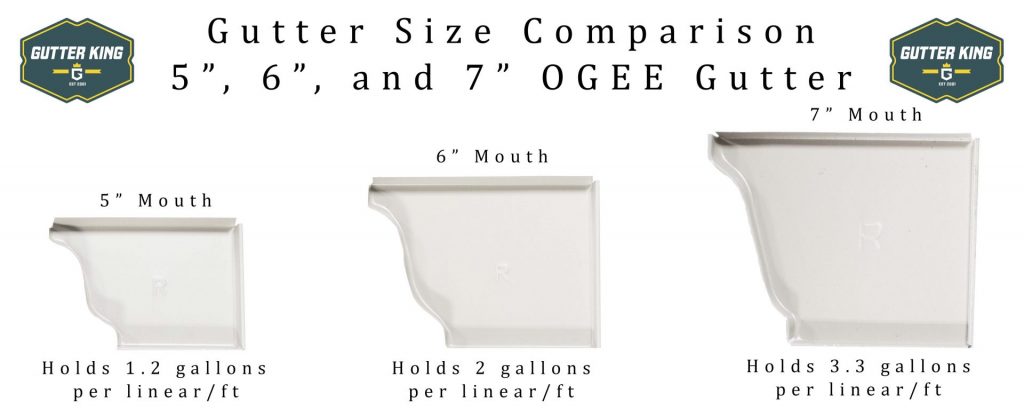Gutter Sizes Guide
Contents
When it comes to managing the flow of rainwater around a property, having the right gutter size is essential. Gutter size and capacity have a significant impact on how well your roof drains, preventing water from damaging the foundation of your home. Knowing which type and size of gutter will ensure that it can handle the amount of rainfall in your area is vital. When selecting gutters for your home, understanding the various sizes and types available is key.
Gutters come in various sizes, each with a different capacity. Sometimes it can be tricky. A 5″ OGEE or Straight-Face gutter carries the same capacity as a 6″ half-round. 6″ OGEE and straight-face have a 40% larger capacity than 5″ gutters. A 7″ gutter will have an even larger capacity, but that’s not always the reason to go to 7″.

What factors should I consider when choosing a gutter size?
The factors we consider when choosing a size go in this order:
1) Roof Type
This part is pretty simple. 5″ gutters can only possibly work on a composite shingle roof, assuming there are adequate downspouts and not a massive volume of water. Metal and clay tile roofs shed water too quickly. The gutter is often much lower than the top of the roofline, so the water “shoots” over the gutter and misses it entirely. The measurement we are referencing (5″, 6″, and 7″) is the measurement of the mouth of the gutter, or from the back to the widest part of the front. At Gutter King, metal roofs and slate tile roofs automatically get upgraded to 6″ gutter so we can ensure the water doesn’t miss the gutter. Because of the channels formed in the tile, barrel tile roofs need an even larger opening of 7″, so we always recommend 7″ gutters on barrel tile roofs. In most cases, barrel tile roofs shed a lot of water.
- Composite shingle roofs – 5″ gutter is usually acceptable
- Metal Roofs (standing seam and screw-down) and slate tile: 6″ is necessary
- Barrel Tile Roofs – 7″ gutter is best
2) Downspout locations and length of run
The “Bottleneck” in your gutter system will always be your downspouts. There are a couple of rules that we try to follow whenever we can. First, we never want to go more than 35′ of roofline before we get to a downspout. Second, we need to ensure the spouts have the proper capacity ratings. It’s also imperative that the hole in the gutter going into the downspout isn’t smaller than the downspout; otherwise, you’re limited to the hole’s capacity. Each 3″x4″ downspout handles about 1200 s/f of roof plan from a bird’s eye view. If we need to exceed the 35′ or we don’t have enough capacity with the downspout, upgrading your gutter size is a good idea to allow time for the gutter to drain before it overflows.
3) Water capacity
It may come as a surprise that water capacity makes the third consideration. As we mentioned in the earlier two points, if the water can’t overshoot the gutter and has plenty of drainage points, then capacity isn’t a concern. Gutters are designed to move water, not hold water. However, water capacity is often considered when we see a very large roofline with heavy-flow points and valleys. These are often addressed with valley shields, but sometimes it’s better safe than sorry.
4) Region
Really? Absolutely! If you’ve ever spent time in places like California, you’ll notice that most of the rain they get comes in reasonably gently. Showers aren’t necessarily gully washers, and most of the time, the water from a roof will flow gently into a small gutter and not overshoot it. If you’ve been in Texas any time, you’ve probably noticed it pours when it rains. Our large storm systems will often drop several inches of rain in a brief period, and you want to be prepared for the heaviest rains, not the lightest ones. At a minimum, Gutter King recommends 6″ gutters on EVERY house in Texas.
5) Style
Gutter King is all about the look and functionality of your system. Many customers prefer the look of a 6″ gutter over a 5″ gutter simply because they look nicer. A 5″ gutter often looks like something is hanging on a fascia. The height of the gutter is smaller than the height of the fascia. With a 6″ fascia, the gutter often fills the fascia, and it blends in nicely. Our 6″ straight-face gutter even mimics the look of a traditional trim board.
How to Measure Gutter Length
To measure the length of a gutter, you will need a measuring tape or a measuring wheel. Here are the steps to measure the length of a gutter:
- Choose the section of the gutter you want to measure. The length of a gutter is usually the distance between two downspouts or the length of a single run.
- Start at one end of the gutter section and extend the measuring tape or wheel to the other end. Make sure the measuring tape or wheel is level with the bottom of the gutter.
- Note the measurement in feet and inches. If you are using a measuring tape, the measurement will be displayed on the tape. If you use a measuring wheel, the measurement will be displayed on the wheel’s counter.
- If the gutter has multiple sections, repeat the process for each section and add the measurements together to get the total length.
- Add an extra 10% to the total length for waste and overlap. This will ensure you have enough gutter to cover the entire roof without any gaps.
If you are unsure how to measure the gutter, you can consult a professional gutter installer like Austin Gutter King. We can help you determine the appropriate length and size for your gutter system.
How to Measure Gutter Downspout Size
The size of a gutter downspout is typically determined by the amount of water it needs to handle based on the size of the roof area and the average rainfall in the area. Here are some steps to measure the gutter downspout size:
- Measure the area of your roof: Measure the length and width of your roof, then multiply them to get the total square footage. This will give you an idea of how much water needs to be drained from the roof.
- Determine the average rainfall in your area: The size of the gutter downspout also depends on the average rainfall in your area. Check with your local weather bureau or search online for the average rainfall in your area.
- Use a gutter size calculator: You can use a gutter size calculator to determine the size of the gutter downspout based on the area of your roof and the average rainfall in your area. Many gutter installation companies offer free online calculators that can help you determine the appropriate size.
- Consider the shape and material of your gutter: The shape and material of your gutter can also affect the size of the downspout. For example, a round gutter may require a larger downspout than a square one. Additionally, different materials can affect the size of the downspout.
Generally, a 2×3-inch downspout is suitable for a small to medium-sized roof area. In contrast, a 3×4 inch downspout may be necessary for a larger roof area or a location with heavy rainfall. It is best to consult a professional gutter installer if you are unsure about the size of your gutter downspout.
Choose the Gutter Company Austin, Texas Homeowners Can Trust
Homeowners will likely be given a wide variety of options for their homes, including multiple sizes, materials, styles, guards, etc., for their gutter system. A professional must help you determine the correct size for your home to ensure your system is functional under every condition. Gutter King recommends a 6″ Gutter over a 5″ because of the large storms and heavy downpours. Should you find yourself on the fence about one size, you’ll never regret going up a size, but you might regret going down.
At Austin Gutter King, we have over twenty years of expertise in helping our clients find the gutters they need. Regarding gutter installation, Austin, Texas, residents know they can rely on Austin Gutter King. Contact us for a free consultation to help you choose the right gutter size!
